
Click here to view website on mobile

Changes to the drinking scene in Ludlow. January 2016 There have recently been a number of changes to the Ludlow pub scene. On Christmas Eve 2015, Ludlow's " first" parlour pub was opened at 14 Corve Street. Named "The Dog Hangs Well", it is open 3 days a week. On Thursday and Friday it is open from 5 to 9 pm and on Saturday from 12 to 3 pm and 5 to 9 pm. The only" pub sign" is a lamp above the door. When it is lit the pub is open. Go through the door and along the corridor and open the door on the right and it is there on the left. Parlour pubs, a room in someone's house were beer was served, were the fore runners of the modern public house. For many year, "The Sun" at Leintwardine, closed when the land lady Flossy died, was the only parlour pub in the area. ( It is now open as a pub but the two rooms used by Flossy, at the front of the building, remain as they were in her day.) A real ale bar has also opened at Artisan Ales in Old Street. It is open until 9pm and is above the beer shop. The Rose and Crown, Church Street, one of the oldest buildings in the town was closed in November and is due for a much needed refurbishment. The work is supposed to starts during January and is likely to take over 6 months but you can never tell when they start knocking about very old buildings. Ludlow's Shakespeare and Arts Festival 2014. After a period of uncertainty Ludlow's Shakespeare and Arts Festival made a welcome and powerful return under the festival directors Chris Davies and Chris Moreno. In conjunction with the Stafford Gatehouse Theatre, an excellent production of " As You like It" was put on with a strong cast headed by John Challis and Eric Potts. Unlikely previous years, the stage and seating were covered so you no longer had to take plastic bags in case it rained. The arts festival opened with a sell out for Fascinating Aida in the Big Top (and it was a Big Top.) They were excellent but my favourites were the Jazz and Blues Sunday with the likes of Courtney Pine, Jacqui Dankworth, Ruby Turner and Digby Fairweather and the open air concert with Bellowhead. Another improvement on other years was the standard of catering and drink outlets. I hope the Festival goes from strength to strength. But, as is usually the case, there were mutterings that things weren't like they used to be; they weren't thank goodness. It's the first festival where we could have gone to watch something every night. As it was, we got to seven events. The walls came tumbling down. March 2013 In the early hours of 17th February a 30 foot stretch of the medieval town wall at the top of Upper Linney, beyond where the Linney Gate Tower used to be, collapsed. It happened at about 3 am and happily no one was injured; this section of wall not being behind any houses. The town wall, much of which still survives, dates back to the thirteen century. However, the wet summer and cold winter have taken its toll on this ancient structure. After the initial collapse more of the wall was in danger of moving and large bags of earth have been used to buttress this section. Work on repairs will start once English Heritage have given approval; but, at the moment, just how large an undertaking this will be is still being investigated. It must be worrying for the many residents of Upper Linney whose houses back on to the old town wall. 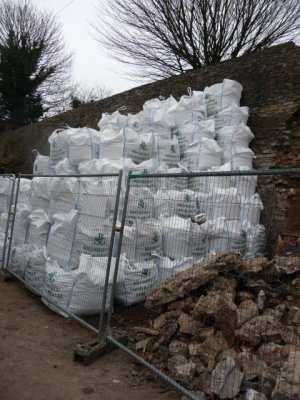 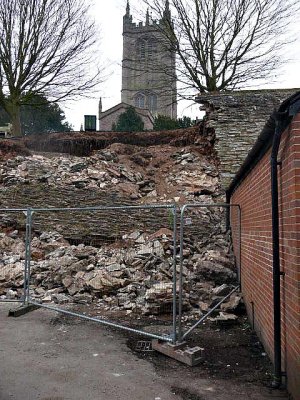 Tricks played by full moon. It was last year that we first noticed this strange phenomenon when staying at Waterside and saw it again this year in January. After mid night when the full moon is shining on the Horseshoe Weir, the top edge of the weir looks like lights have been installed in it. It is quite magical and lasts for about 20 minutes. We think it is caused by the moon light reflecting off the water as it bubbles over the top of the weir. Cows invade centre of Ludlow. On Tuesday 10 January, in the early hours of the morning, 40 cows from a farm a mile outside Ludlow made their way to the town centre damaging cars, gates and buildings. Locals reported the cows stampeding through the streets. Eventually they were rounded up in a car park and returned to the farm. It still remains a mystery how they got out and wandered so far from the farm. Salmon update. 02/12/11 On our next visit to Ludford Bridge to see the salmon we watched for about 15 minutes. During this time, several salmon jumped up out of the water but remained in their place under the first arch of the bridge. One of the men from the environmental agency said the salmon do this to get rid of water lice. Apparently these lice can only attach themselves when the salmon are not on the move. So the salmon jump occasionally to get rid of the lice. Also, there were so many under the bridge as there was not enough water for the larger ones to get over the other weirs. If it does not rain in the next few days, the salmon will be netted and taken to the spawning grounds. However, this is an action of last resort because of the distress caused to the fish. Also, he said that although most of the salmon do die when they spawn some do make the journey back down the river. However, most are too exhausted as they do not eat when the make their swim to the spawning grounds. The salmon have arrived. On Tuesday (22/11) we were walking down Lower Broad Street towards Ludford Bridge. We noticed a group of people staring over the bridge and had to find out what was causing the interest. In the water, by the first arch of the bridge, were 10 large salmon. Occasionally one would jump out of the water. They were resting having just negotiated the Horseshoe Weir and preparing for the next weir at Mill Street before their final hurdle at Dinham Weir. They were being monitored by two men from the environmental agency who told us a large group of salmon were making their way up the river. Earlier in the week poachers had put nets across the Mill Street Weir. The salmon are late this year as the River Teme has been so low until about 10 days ago. The salmon are making their way to the gravel beds beyond Dinham Weir were they go to spawn. And, once they have spawned they die. Changes at Horseshoe Cottage. Over the last 2 weeks we have had the builders in clearing two ancient sheds at the bottom of the garden and putting down a concrete base for a wooden summer house. The summer house is now up and we are in the process of tiding up the garden and making a new small pond for the resident frogs. We have wanted to do this for some time as it has freed up more garden space whilst giving us an extra amenity for our guests to enjoy next year. Eating out in Ludlow Ludlow boasts an enormous number of superb restaurants and places to eat. Click here for some places that we have enjoyed recently. Ludlow May Fair There has been a fair in Ludlow for hundreds of years and the poet A E Houseman mentioned it in his poem, A Shropshire Lad, written in 1896 There's men from the barn and the forge and the mill and the field, The lads for the girls and the lads for the liquor are there, And there with the rest are the lads that will never be old. 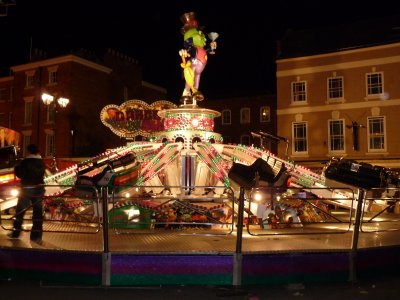 And, when it comes to the fair I consider myself as one of “the lads that will never be old” as, after 60 years, I still enjoy the noise, bustle and excitement. There have been fairs in Ludlow since the thirteenth century and possibly earlier. The present fair always includes the first Monday in May and starts on the proceeding Thursday. There is some argument over why it centres on the start of May but it may date back to when St. Laurence’s Church was also dedicated to St. Phillip whose Saint’s Day was May 1st though equally it may not. Certainly before the industrial revolution May 1st was a traditional holiday in the country side often accompanied by May Pole dancing. 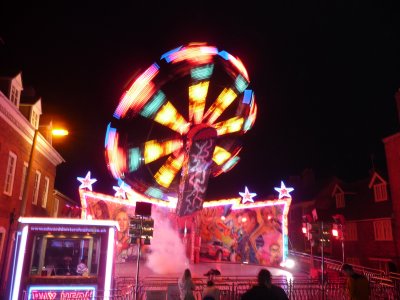 When I was young in the 1960s, some of the fair would arrive about a week before it was due in the town centre and would be set up the field behind the Horse and Jockey Pub. The field has long since been covered in houses. The May Fair is now only held in the town centre with all the stalls and rides that are part of the traditional fun fair. When I was young part of the excitement was watching the lorries arrive in the town centre and the rides being set up. I always try to get over to Ludlow when the Fair is on as it is a good time to meet up with old friends who you only seem to meet up with at that time and see their children and grand children enjoying the Fair as much as we did. Though, I still love the big rides that turn you upside down and because of their close proximity to the buildings give you the impression you are going to crash into them until you are whisked away at the last minute. 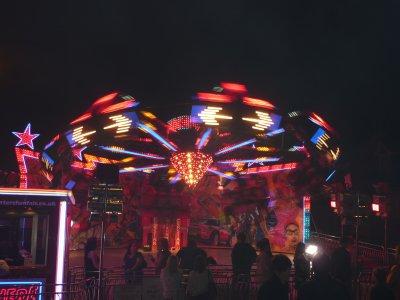 In recent years “new comers” to the town have tried to get the Fair moved to outside the town, disliking the noise, bustle and the fact that the town centre is taken over by the Fair. The last attempt was in 2009 but thank fully failed. Ludlow Self Catering Cottages now have an Energy Performance Certificate (EPC) each. It was an email that alerted me to the fact the from April 2011 self catering properties needed an EPC and that a certificate is compulsory from June. (Scotland is not included in this bit of madness.) If you do not have an EPC after that date there is a heavy fine. I can just about see why one might provide useful information if you are buying a house but I cannot see the use of one to someone who is staying in one of our properties for a week or over a week-end. Also, once you have obtained one they are valid for 10 years. What is the point? However, the good news is getting an EPC is not difficult, I found someone local to Ludlow who was qualified to do this, and not too expensive, £45 per property. It takes about an hour to do a house and now I have three EPCs and the results are not a surprise. As an estate agent said to me the other day, “Tell me how old the property is and I will tell you the EPC grading, it’s that simple.” In one house the boiler is six years old but is not a condenser. The report suggests I could save £80 a year if I got a new condensing boiler. The only snag is that would cost £1000+ to replace a perfectly good boiler. Also what about the carbon foot print a new boiler would come with? As a society, we are too keen to buy new rather than repair and this comes at an energy and carbon cost but this is not considered by an EPC. I also scored lower in 2 houses as there were not enough low energy bulbs in the right sort of fittings. This is because the accommodation has dimmer switches and low energy bulbs do not work well in them. Also although we have low energy bulbs in bed side lights and table lights these do not count towards your assessment as only fixed lights are counted. Mad, as I do not know about you, but we tend to use table lights rather than “fixed” lighting most of the time. And, I do not know if we have been unlucky, but our low energy bulbs do not tend to last, we have replaced three this year under 12 months old and another six because they were earlier models and had diminished in their light out-put which was also a distinct shade of yellow. In addition, it would appear that disposing of them is going to be increasingly difficult as some councils do not want them put in with general waste because of the mercury content and the vapour that is given off if the glass is smashed. So not only do these new” low energy” bulbs take more energy to produce they will soon “cost more” to dispose of safely. Ah progress. Ludford Bridge open again. When we travel to Ludlow we usually enter the town via Ludford Bridge. But, when we approached the bridge from the B4361 in the second week of January we were faced with diversion signs taking us over Whitcliffe. This would normally be a pleasant little drive but following all the snow that morning you had to be very carefully on the two sharp bends before the road winds down to Dinham and over the bridge t and into town. When we arrived at our Waterside accommodation we could see what the problem was. Virtually all the stone facing above the middle arch had come and away and fallen into river. When we read the comment sheet in Waterside, our last guest had seen the whole thing, on January 4, being altered by a loud cracking noise. Apparently water had got behind the facing stone, frozen and forced the facing stone off. Speculation was that the when the facings had been re-pointed in the past too much cement was used instead of lime mortar, lime allowing moisture to pass through. 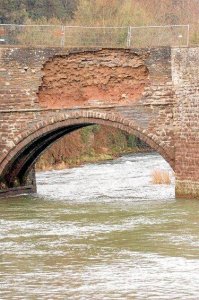 The bridge had been closed to all vehicles though you were still allowed to walk across it or push your bike across. Nothing appeared to happen for several weeks but during the third week of February rather complex scaffolding was put round the arch way. It was hoped that the bridge would be open again by Easter, the work supposing to take 9 weeks. But, many locals, including myself, had our doubts as it had taken so long to get the work started. But, we were proved wrong as the bridge re-opened to traffic on 14 April ahead of time. 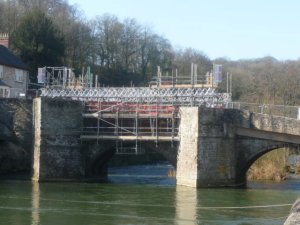 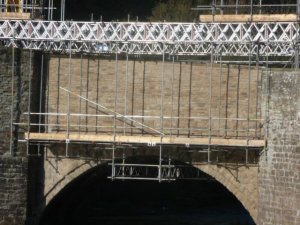 Previous Bridge Closures Ludford Bridge is very old with parts of the existing structure going back over 600 years, though most of the bridge as now seen is some 300 years old. At one time, there was a chapel on the bridge dedicated to Saint Catherine. The bridge may have also witnessed one of the more significant events of The Wars of the Roses known as the “Rout of Ludford Bridge.” Ludlow at that time, 1459, was a Yorkist strong hold, the castle being the property of Richard, Duke of York. On about the 10 October 1459, a Yorkist army that had come from Teweskbury gathered south of Ludlow at Ludford Bridge, where they dug a ditch and fortified it with artillery. However, they were to be heavily out-numbered by the Lancastrian forces of King Henry V1 that came through Ledbury and Leominster. On the 12 October the two armies faced each other across the River Teme. Artillery fire was exchanged during the evening but by the 13 October the Yorkist forces had stolen away in the night deciding that their cause was a hopeless one. Duke Richard fled his castle for the safety of Dublin leaving his duchess and two younger sons to the mercy of the king. Henry V1 entered Ludlow on 13 October and the town was plundered. “The Rout” was significant because it marked the evaporation of support for the Yorkist cause. When I was about 10, I remember my father taking me down to the bridge to see an accident. The bridge was closed because, for some reason, a lorry carrying washing machines and other white goods had toppled over the bridge into the river. There in the water on its side was the lorry and all around it were washing machines. It’s the sort of thing you never forget, a river full of washing machines. These days the only things you will see in the river are a rich variety of fish such as, trout, grayling, chub, pike, roach and barbell. In October you can often see salmon jumping the weirs. Fishing therefore tends to be one of the reasons some of our guests come to Ludlow and I look forward to taking up angling again when I retire in the not too distant future. Magnalonga. In our Ludlow accommodation we keep comment sheets so that anyone staying in one of our self catering properties can tell us and any future guests about places they have visited, restaurants they have eaten at or anything of interest. I always read through them but was puzzled by a comment last year from a guest who had stayed in August that said, “We really enjoyed the Magnalonga. It was a great day out.” I had not a clue what they were talking about, what was a Magnalonga? I mentioned this to a Ludlovian friend a few days later who went into rapture about the Magnalonga. So what is the Magnalonga? Well, it’s a walk with an important difference, it’s a food and drink walk that celebrates local food and producers. It is usually between 6 and 7 miles long starting and finishing in Ludlow. During the walk in the countryside that surrounds the town, walkers make several stops to sample local food complemented by local real ale or cider or perry. It is now in its ninth year and is apparently an idea borrowed from Ludlow’s twin town of San Pietro in Italy. I cannot pretend to be a keen walker but cannot wait to join one as the Magnalonga is definitely my kind of a walk. |
Tel: 01584877667